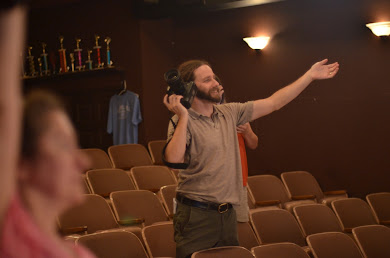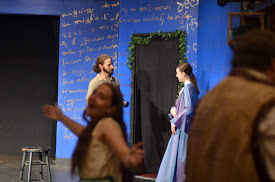It was a lot of fun and gave me the chance to work with lighting and equipment I haven't handled before. The last class was to film a "5 second video", which we could write ourself. I of course love writing so thought about several ideas. I went through old Non Sequitor comic ideas. The first 5 of the following came from Non Sequitor. The last was motivated by an ad I saw many many years ago, for a college that taught painting. It had the model at an easel painting the painters sitting in front of her.
- Deer dressed as St Peter at the gates of heaven.
Camera on Hunter with shotgun waiting to be admitted.
Camera pulls back to reveal Deer as he says to Hunter:
``Let's just call it karma.''
props: deer outfit, white robe, hunting rifle, hunters jacket,
pedital with white and gold cloth draped over it.
- Doctor in an office holding an x-ray, patient in gown on examining room table. Doctor says to patient: "You have a severe blockage of your credit rating."
props: x-ray, patient's gown, doctors lab coat, doctors stethescope, examining table
- A panel of people at a table marked "Reality Show Casting", with piles of papers in front of each panelist, marked "Psychos", "Bigots," etc. One panelist reads out loud an application from a normal person (eg, "I work at the family business and like to play scrabble and sing in the church choir ...") and his horrified.
props: table, signs, lots of papers and manilla folders
- Camera shots CU of Dog is lying down on a couch in a psychiatrists office: "bark, yap, bark, yap, ..." Camera pulls back to reveal that the psychiatrist is a Cat.
props: coach, chair, office furniture, dog outfit, cat outfit
- Crowd in art gallery staring and taking about a painting: "I like the artists' use of color." "Reminds me or Picasso." etc. Young Nerd says ``I wonder what software they used for the brush strokes?''
props: art museum, young nerdy looking actor, crowd of extras
- Have scene of actors performing a scene in Romeo and Juliet.
Juliet: "Romeo, oh Romeo, wherefore art thou Romeo?"
The person handling Camera A is zooming in and out saying "Zoom" under his breath.
Director (standing next to Camera A): Camera A. CAMERA A!
Camera A: Who? Me? What?
Director: Let's try a medium shot on this one, instead of a zoom. Does everyone agree?
All: Yes!
This is caught by Camera B, which shoots the entire scene, cast and crew.
props: cameras and lighting gear, actors, extras
Jeffrey selected the last one and allowed me to be director. Although I had no idea what I was doing, and Jeffrey had to help out a lot, this was tremendous fun. Here it is (edited by Jeffrey):
Workshop Skit from Jeffrey L. Gangwisch on Vimeo.
























